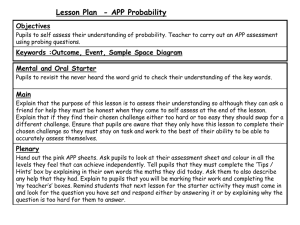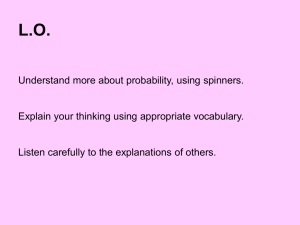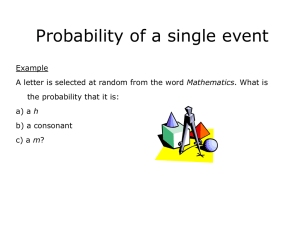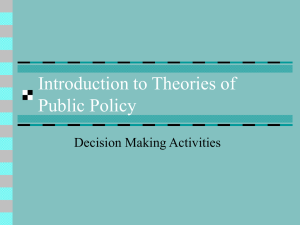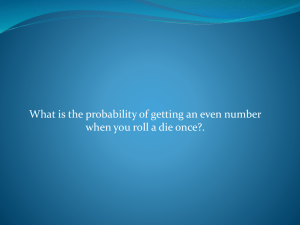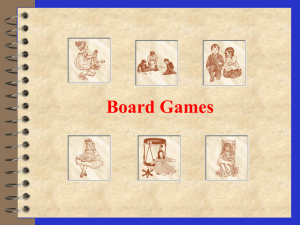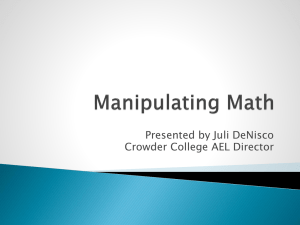File - Nicole M. Wessman
advertisement
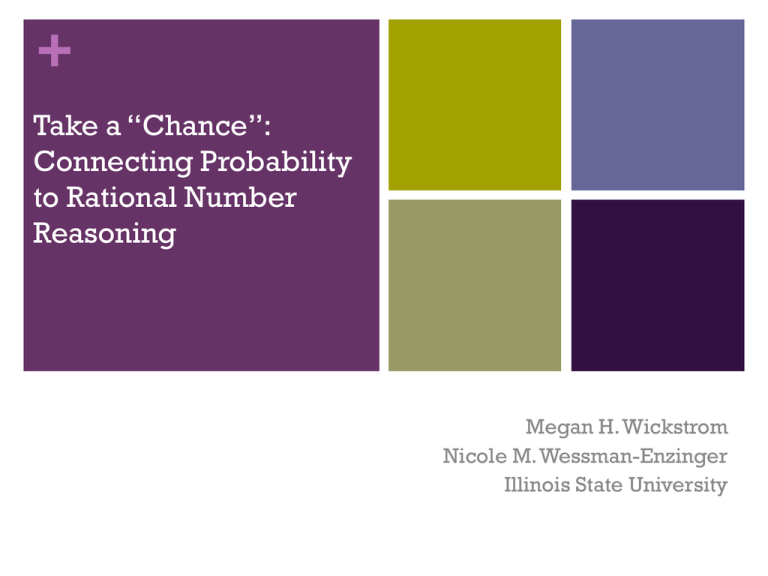
+ Take a “Chance”: Connecting Probability to Rational Number Reasoning Megan H. Wickstrom Nicole M. Wessman-Enzinger Illinois State University + What will we discuss? Example Lesson “A New Spin on Fair Sharing” – A lesson using probability to elicit students’ rational number reasoning Play, Participate and Discuss Games Dice Difference Modified Roller Derby Twister + Rational Numbers in Context Probability is often integrated into curriculum to explore rational numbers or to extend student thinking. Rational Number thinking is considered fundamental in the comprehension of probability It’s important for students to have different kinds of experiences with rational numbers so that they extend their thinking. Probability Misconceptions can challenge students thinking Helps to place rational numbers in a real context + A New Spin on Fair Sharing Classroom lesson taught with 2 fourth grade classes. Objective: Provide students opportunities to make connections to the equivalence of rational numbers through play with spinners typically utilized to teach probability. + The Problem: Fair Sharing Problem: The principal has bought candy for the fourth grade class because they have been so good. When she gets to school, she realizes that she miscounted and she didn’t buy enough candy for everyone. A fourth grade student suggests that maybe the candy should go to only the boys or only the girls. The principals thinks this is a good idea and suggests using a spinner to help decide who gets the candy. The red color represents the girls and the blue color represents the boys. Alternate: Race Problem + The Spinners + What did the students see initially? Students were asked, which spinner the teacher should pick and why? Some students focused on which spinner was their favorite (superstitious beliefs) Some focused on the layout of the spinner (boy, girl, boy, girl versus mixed up pieces) Only 3 of the students from both classes said they were all the same + Sample of Student Response + Sample of Student Response + Students play with spinners and record findings + Focus on Fairness After the students played they submitted their results and we compiled them (200 spins per spinner or you could use tinkerplots). Heard the word “fair” several times by students. Fairness issue. helped us to focus on the equivalence Students discussed fairness and if they thought each of the spinners were fair. What would the results look like if the spinners were fair? What would they look like if they were unfair? + Students Perceptions of Fairness Fairness means 50/50. “I will win about half of the time and my friend will win about half of the time.” Students thought that most of the spinners were probably fair except for: + The Reveal Girls Boys 82 Spins 81 Spins Spinner F 50% 50% 87 Spins 92 Spins 48% 51% Spinner D + Different But The Same?? After seeing all the results, students were asked how could the spinners look different but have the same results? Spinner A as a benchmark to compare Focus on number of pieces in each spinner Focus on number of pieces and same size pieces Using math/equivalent fractions to show they are the same. + Student Work: Expressing Similar Fractions + Student Work: Spinner A as benchmark + Lessons Learned Always It’s important to have students make these connections, but they are good at redirecting the focus. Have a plan to help them focus (for us that was the focus on fairness and equivalence). Two on your teaching toes! Contexts = Double the Misconceptions This lesson is a nice extension/introduction to either topic but it shouldn’t be the only way students see fractions or probability. + It’s Your Turn! We are going to have you play some probability games. As you play the games, talk about how you think the students will use rational numbers (if at all) and what kind of use rational numbers have in the task. + Dice Difference Rules: You will play with partners. The oldest player is the “high player.” The youngest player is the “low player.” Toss the dice and take the difference. The “low player” wins with a difference of 0, 1, and 2. The “high player” wins with a difference of 3, 4, and 5. + Dice Difference Play the game 25 times and record the number of times “high player” wins and the number of times the “low player” wins. + Dice Difference Discussion What do you think? What kinds of mathematical ideas would you talk about with your class? + Dice Difference We have played this with a variety of students. No student has ever stated that they thought the game was unfair before the game begun. Similarly, most students have been surprised when they may lose by a lot. After the game has been played and the student record their results on the board, the students’ discussion start buzzing. Students notice something is going on. But, when we questioned them their answers lack precision mathematically. + Dice Difference: Our Students We challenged our students to consider the sample space, or all of the possible outcomes of this game. Our students struggled to organize their data into a chart. Most of our student organized their results in organized lists or order pairs. Most students said the sample space was 21, rather than 36. Why do you think that happened? + Dice Difference Change Challenge 1 2 3 4 5 6 1 0 1 2 3 4 5 2 1 0 1 2 3 4 3 2 1 0 1 2 3 4 3 2 1 0 1 2 5 4 3 2 1 0 1 6 5 4 3 2 1 0 + Dice Difference: Our Students As the students accepted the organization of the chart and the sample space of 36, we challenged our students to consider if this game was fair. With the introduction of “fairness” we began to approach ideas of rational numbers. How do you think the students discussed fairness? + Dice Difference Sample Space 1 2 3 4 5 6 1 0 1 2 3 4 5 2 1 0 1 2 3 4 3 2 1 0 1 2 3 4 3 2 1 0 1 2 5 4 3 2 1 0 1 6 5 4 3 2 1 0 + Dice Difference Change Challenge How can you change the rules of Dice Difference to make the game fair? + Roller Derby with a Twist Play with a partner Each player receives 10 chips that they will then place on the board During the game, you will roll both dice and add the two numbers together to get a sum. If you have a chip(s) on that sum you may remove one chip from the board The first person who removes all their chips is the winner! + Students at Play Common Student Misconceptions Challenge students to write down initial strategies and how their strategy changed each time Placing chips evenly across all the spaces Placing chips on the space marked 1 Matching another student (initial strategy) Seeing sums that seem to come up more often than others Learning from prior games Challenge the students to model the game using rational number reasoning. Questions like why are we seeing a sum of 6 more than a sum of 2? Students can begin to articulate this such as there is only one way to make a 2 but there are several ways to make a 6 + 1 2 3 4 1 2 3 4 5 2 3 4 5 6 3 4 5 6 7 4 5 6 7 8 + 1 2 3 4 1 3 4 5 6 2 3 4 5 6 3 7 4 5 6 4 7 2 5 8 + Your Turn! Use Dice Difference and Roller Derby to help you come up with your own twist. What kind of game with dice could you use to talk about probability and rational numbers? + Twister In the popular game of Twister® people spin the following spinner to determine where to place their body parts (i.e., left hand, right hand, left foot, right foot) on various colored dots (i.e., yellow, green, blue, and red). Using Twister as a context, brainstorm some probabilistic and rational number topics that you could discuss in your own classroom. + A Twister Task: What do you think? What kinds of probability topics and rational number topics would you talk about? What kind of questions would you pose? + Task #1 Suppose that you are making a homemade Twister® game. You want to account for all of the rules and possibilities that are part of the original game; however, you want to use multiple spinners. How can you use multiple spinners, where you need to spin at least twice, to generate the same sample space as the traditional Twister above? Draw your new spinners below. Describe how you would use these spinners and how these generate the same sample space as the spinner above. + Task #2 You spun the original Twister spinner above, 20 times. You landed on “left hand, yellow” twice. What is the experimental probability? What is the theoretical probability? Explain why the probabilities are similar or different. + Student Responses Students struggled coordinating the difference between experimental and theoretical probabilities. This struggle highlights the need to recognized our “whole.” Is the whole the number of times we spun? Or, is the whole the sample space (or number of possible outcomes)? + Task #3 While playing the game, Kyle argues that the Twister game board affects the probabilities because, while playing, he notices that more people have their hands and feet on the yellow dots compared to the other dots on the board. How would you respond to Kyle? + Task #4 Daric said that if he made a new board, this would also change the probabilities. Daric’s “new” board is shown below. How would you respond to Daric? Is the game still fair? + Student Responses Students struggled coordinating separating that the board is independent of the spinner. Many students held the misconceptions that the changing the board changed the probabilities. Descriptions of past experiences playing the game helped the students overcome their misconceptions. + THANK YOU! (THANK YOU!)2013 Please feel free to contact us: Megan: megawicks@gmail.com www.meganwickstrom.com Nicole: nmenzinger@gmail.com www.nicoleenzinger.com
